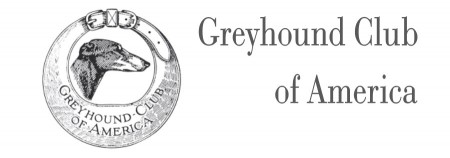All Sighthound breeds depend on good feet as part of their running gear. The construction of the Greyhound foot is paramount to their function as a coursing breed. The foot needs to be flexible to adjust to the weight of the dog as it moves through its’ double suspension gait as well as the trot. The foot is characterized by long well arched toes. The word long is significant, without length, the Greyhound foot would be cat-like and more rounded as in the foot of a Doberman. The Greyhound foot has an oval shape with the middles toes being the longest on both the front and back feet. It was not always this way. While reading from “The Illustrated Book of the Dog” by Fra Vero Shaw, 1879-1881 a discussion appears of the controversy of cat foot vs. hare foot. The English standard at the time called the feet round, well split up, and with strong soles and the poem about greyhound written in 1486 by Dame Julia Berners describes the foot as “footed like a catte”. Over the years, the best foot for a Greyhound’s job is described as more hare than cat, finding a middle ground between the two and is that which appears in the current America standard. In any case, short toes will give the appearance of knuckling over, particularly when paired with upright pasterns. Typically, nails are longer than may usually be seen in the ring. It is not because Greyhound owners are lazy or don’t think short nails are worth the fight, but because it is part of the grip on the ground as the Greyhound launches itself into the next phase of its double suspension gait.
The pastern is also part of the construction of the foot that lends itself to the task of landing the foot on the ground and enabling a push off. The pasterns should have bend to them when standing naturally and if you watch these dogs course, you can see how far that pastern actually bends. The pads of the foot are also key to making the foot hold up to its task. Pads are thick to cushion the foot while running. Again, Greyhounds share this with many other Sighthounds and is mentioned in many of the Sighthound standards. Particularly the stop pad, above the pastern has the job of doing just that, stopping the pastern from bending further.
Splayed feet, with space between the toes, thin pads, and flat feet are not in keeping with proper foot construction. Just as in humans, foot deformities lead to pain, especially when stressed by performance activities. These stresses and the shifting of weight away from the pain point lead to injury of the toes, ligaments, and muscles of the foot.
In an interesting study of Greyhound feet conducted at the Purina Dog Care Center, it found that Greyhounds raised on concrete runs developed flat feet whereas those raised on sand and clay developed normal feet. Once knuckles of the toes flattened out during a puppy’s teething period, not much could correct the problem.
The Greyhound Health Initiative has been working on a greyhound foot problem, corns, in conjunction with Michael Guilliard, DVM, Richard Doughty, DVM and Bill Freeman III, DVM, researchers for this project. A corn is a hard mass of keratin-like tissue, they are found frequently in the pads of Greyhounds. The corn is similar to human corns appearing as a circular area that can be raised. Corns tend to have deep roots that interfere with a nearby tendon and the bones associated with this process. Typically, they are not found on the large pads of the front or back foot. Most are found in the central digits of the front legs and are a source of considerable pain and lameness. The researchers are interested in finding more greyhounds with this issue and if you wish to take part in the study, contact one of these veterinarians via email at info@greyhoundhealthinitiative.org.
In closing, feet hard and close, rather more hare than cat-feet, well knuckled up with good strong claws describes the foot from the American Greyhound standard. Our breeders are doing a good job getting this right and flat splayed feet are few and far between!
